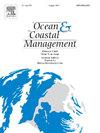长江口潮滩资源的多年代际动态:原因与威胁
IF 4.8
2区 环境科学与生态学
Q1 OCEANOGRAPHY
引用次数: 0
摘要
全球变化下滩涂资源的长期变化引起了世界各国的关注。以往的研究主要集中在滩涂的面积变化或地貌变化上,但很少将这两种方法结合起来。本文利用地形、遥感和水文数据,分析了长江口浅滩(包括横沙浅滩、九段浅滩和南汇浅滩)的多年代际动态变化及其潜在的土地资源风险。1958 - 2019年,三个潮滩的总面积分别增加了0 m (52-94 km2)和- 5 m (4-188 km2)。然而,2000年以后,吸积率下降,沉积集中在内陆地区,而侵蚀开始影响向海边缘。2002年以来,横沙浅滩和南汇浅滩由于密集填海,土地资源分别减少了47和72 km2,而九端浅滩由于未进行填海,土地资源增加了60 km2。大坝引起的河流泥沙减少是潜在的潮滩侵蚀的原因之一,通过人工构筑物的建设和沼泽植被的种植可以部分地抵消工程促进淤积的影响。相对于增退,近年来大规模填海在滩涂资源动态中发挥了重要作用。持续的小河流输沙、海平面上升加剧、坡度变陡等因素增加了滩涂的土地资源风险。为此,应采取江口一体化管理、科学促淤、合理填海设计等措施。这些发现为全球其他大型河口滩涂资源的可持续利用提供了启示。本文章由计算机程序翻译,如有差异,请以英文原文为准。
Multi-decadal dynamics of the Changjiang estuarine tidal flat resource: Causes and threats
Long-term changes in tidal flat resources under global change have garnered worldwide attention. Previous studies concentrated on either area variations or geomorphic changes of tidal flats, but have rarely bridged these approaches. In this study, we examined the multi-decadal dynamics of the Changjiang estuarine tidal flats (including the Hengsha Shoal, Jiuduan Shoal, and Nanhui Shoal) and potential land resource risks using coupled topographic data, remote sensing images, and hydrological data. The three tidal flats experienced increases in gross area above 0 m (52–94 km2) and above −5 m (4–188 km2) between 1958 and 2019. However, after 2000, accretion rates declined, with deposition concentrated in landward regions, while erosion began to affect the seaward edges. Meanwhile, the land resource of the Hengsha Shoal and Nanhui Shoal decreased by 47 and 72 km2, respectively, because of intensive reclamation after 2002, whereas that of the Jiuduan Shoal increased by 60 km2 as no reclamation occurred. Dam-induced riverine sediment decrease contributes to potential tidal flat erosion, which is partly counteracted by the engineering-promoted siltation through artificial structure construction and marsh vegetation planting. Relative to accretion/retreat, recent large-scale reclamation has played an important role in tidal flat resource dynamics. Continuous small riverine sediment supply, increased sea level rise, and steepening slope contribute to increased land resource risks of the tidal flats. In response, measures including integrated river-estuary management, scientific siltation promotion, and suitable reclamation design should be implemented. These findings provide insights for sustainable utilization of tidal flat resources in other mega estuaries globally.
求助全文
通过发布文献求助,成功后即可免费获取论文全文。
去求助
来源期刊

Ocean & Coastal Management
环境科学-海洋学
CiteScore
8.50
自引率
15.20%
发文量
321
审稿时长
60 days
期刊介绍:
Ocean & Coastal Management is the leading international journal dedicated to the study of all aspects of ocean and coastal management from the global to local levels.
We publish rigorously peer-reviewed manuscripts from all disciplines, and inter-/trans-disciplinary and co-designed research, but all submissions must make clear the relevance to management and/or governance issues relevant to the sustainable development and conservation of oceans and coasts.
Comparative studies (from sub-national to trans-national cases, and other management / policy arenas) are encouraged, as are studies that critically assess current management practices and governance approaches. Submissions involving robust analysis, development of theory, and improvement of management practice are especially welcome.
 求助内容:
求助内容: 应助结果提醒方式:
应助结果提醒方式:


